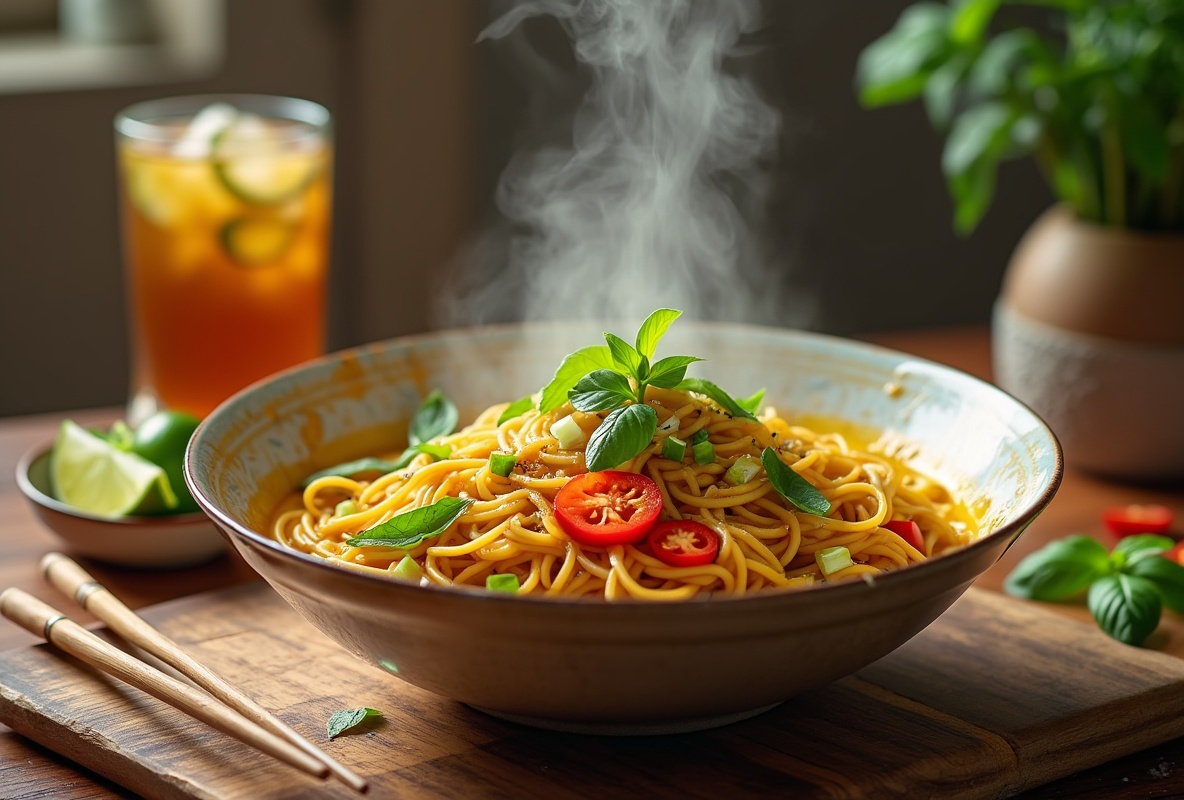Discovering Curry Noodles: A Flavorful Journey
Welcome to our delightful Curry Noodles Eating Guide! Embarking on a journey through the world of curry noodles promises an exploration full of diverse, tantalizing flavors. These dishes bring together the aromatic spices of curry and the comforting textures of noodles, creating an irresistible blend that satisfies both the adventurous and the traditional palate. We’ll dive into various types and styles of curry noodles, because each variant tells a unique story of its culture and tradition. Join me as we uncover the joys and secrets hidden within each bowl.
Types of Curry Noodles to Try
When it comes to exploring diverse curry noodle dishes, there’s a delightful variety waiting to be discovered. One of my absolute favorites is the Thai Curry Pasta, known for combining rich flavors with a hint of heat. The beauty of Thai Curry Pasta lies in its blend of creamy coconut milk, zesty lime, and aromatic spices, offering an irresistible taste experience. In addition to Thai varieties, you might also want to try Malaysian curry laksa, renowned for its spicy broth and shrimp toppings, or the savory Japanese curry udon, which offers a milder but equally delicious profile. Each dish brings something unique to the table. Spices, broths, and noodle textures vary significantly across these versions, making every bowl a fresh adventure. Whether you’re a fan of the hot and spicy taste or prefer something creamy and sweet, there’s a curry noodle out there that will perfectly satiate your craving. So, keep an open mind and let your palate guide you through the world of curry noodles!
The Art of Pairing Curry Noodles with Ingredients
When embarking on the curry noodles eating guide, it’s essential to understand the harmony between noodles and their flavorful companions. Pairing curry noodles with the right ingredients can elevate your dish from tasty to extraordinary. For instance, rich Thai curry pasta benefits immensely from the inclusion of fresh vegetables like crunchy bell peppers and soft carrots, which add texture and vibrancy. Proteins are another crucial element; consider tender chicken or tofu for a satisfying bite. Herbs and spices such as fresh cilantro, basil, or a squeeze of lime not only enhance the aroma but also bring a refreshing contrast to the creamy, spicy sauce. For those who savor a hearty meal, adding boiled eggs or crispy shallots can deliver an extra layer of flavor and texture. By thoughtfully combining these elements, you engage all the senses, turning a simple meal into a delightful dining experience.
Essential Utensils for Eating Curry Noodles
When it comes to relishing Thai curry pasta, having the right utensils can make all the difference in your culinary adventure. Chopsticks are the traditional tool of choice, enabling a perfect grip on those slippery noodles while enhancing your cultural experience. If you’re not confident with chopsticks, a fork can be equally effective. For the broth-lovers among us, a deep soup spoon is essential, especially when savoring rich coconut or savory ginger-infused curry sauces. Don’t forget a nimble spork, combining the qualities of both a spoon and a fork, offering versatility, particularly handy for tackling harder ingredients like chicken or tofu. Having a bowl that is deep enough to mix ingredients ensures flavors are properly combined. For the complete setup, a set of elegant serving tongs can also be helpful in communal settings, allowing you to share various curry pasta dishes with friends and family, blending experience with ease and enjoyment.
Curry Noodles Eating Guide: Step-by-Step Techniques
When it comes to savoring Thai Curry Pasta, I’ve learned a few techniques that enhance the experience. First, always start with the aroma. Let the fragrance fill your senses, as this is the heart of curry enjoyment. Next, gently fork through the noodles to blend the rich curry sauce, ensuring each strand is thoroughly coated. It’s essential to master the art of twirling with chopsticks or a fork, so no delicious drop is left behind. For those like us who appreciate a balanced bite, incorporate vegetables, proteins like chicken or tofu, and even a burst of lime for that classic zest. Be sure to have a plate ready for discarded lime peels or bones. I always recommend pairing the dish with a cooling drink, like iced tea or coconut water, to offset the spiciness. Sharing these culinary techniques with friends and family can turn any meal into a delightful, communal experience. Following these steps reveals the true essence and art of enjoying curry noodles.
Exploring Regional Variations in Curry Noodle Dishes
When it comes to curry noodles, the world is a vibrant tapestry of flavors and traditions. Each region brings its unique spin to this beloved dish. If we venture into Thailand, we discover the rich and creamy essence of Thai curry pasta. Here, coconut milk and aromatic herbs like lemongrass and galangal create a harmonious symphony for the taste buds. Meanwhile, over in Japan, udon curry noodles offer a delectable balance of sweet and savory flavors, often highlighting soy sauce and mirin. In India, the spicy masala curry noodles burst with spices such as cumin and coriander, blending seamlessly with local vegetables and meats. Moving to Malaysia, you find laksa curry noodles, which combine noodles with a spicy broth infused with shrimp paste and lime, delivering a fresh and tangy kick. Each of these regional specialties showcases an intricate dance of local ingredients and traditional cooking techniques, inviting you to embark on a culinary adventure. For more insights on specific regional recipes, check out our best meat choices for ramen.
Tips for Enjoying Curry Noodles with Friends and Family
Gathering with friends and family over a meal of Thai Curry Pasta can be a delightful experience. To make these communal moments enjoyable, I always start with a simple setup: a large table, comfortable chairs, and plenty of chopsticks and forks. Before serving, I prepare a variety of accompanying ingredients such as fresh cilantro, lime slices, and chili flakes. These not only add flavor but also allow each person to personalize their dish. Creating a small station with condiments like soy sauce and fish sauce can also enhance the flavor to individual tastes. Warm bowls are essential, as they keep the curry noodles at the perfect temperature, encouraging more leisurely dining. Sharing stories or discussing the history of curry noodles can deepen the connection and appreciation for the dish. Encouraging everyone to try using chopsticks can add an element of fun and laughter, especially for those unaccustomed to them. Ultimately, the heart of enjoying curry noodles lies in the shared smiles and the joyous togetherness they inspire.
Frequently Asked Questions
What are some types of curry noodles I should try?
There are several varieties to explore, each with distinct flavors. Popular options include Japanese curry udon, Thai curry noodles, and Malaysian curry laksa. Each brings its unique blend of spices and ingredients to the table. To learn more about ramen’s origins, explore the history of ramen noodles.
How do I pair curry noodles with ingredients effectively?
The key is to balance flavors. Consider adding proteins like chicken, shrimp, or tofu. Vegetables such as bell peppers, carrots, and snap peas add crunch and color. Also, fresh herbs like cilantro or basil can enhance the flavor of Thai Curry Pasta.
What utensils are essential for eating curry noodles?
Chopsticks and a soup spoon are typically used. The chopsticks help with noodles, while the spoon captures the broth. If you’re not comfortable with chopsticks, a fork works just fine too.
What’s the best way to eat curry noodles?
Start by sipping the broth to appreciate its flavor, then mix the noodles and other ingredients well. Use chopsticks to lift the noodles and a spoon to catch any broth or smaller bits. Enjoy at your own pace, savoring each bite.
Are there any regional variations in curry noodle dishes I should explore?
Absolutely! Each region offers a unique take. For instance, Thai Curry Pasta may vary by using different curry pastes, while Malaysia’s laksa can range from spicy to tangy. Exploring these variations can be a delightful culinary journey.

